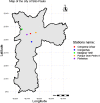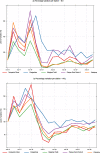São Paulo's atmospheric pollution reduction and its social isolation effect, Brazil
- PMID: 33110453
- PMCID: PMC7582429
- DOI: 10.1007/s11869-020-00959-8
São Paulo's atmospheric pollution reduction and its social isolation effect, Brazil
Abstract
Since January 2020, studies report reductions in air pollution among several countries due to social isolation measures, which have been adopted in order to contain the coronavirus outbreak progress (COVID-19). This study aims to evaluate the change in the atmospheric pollution levels by NO and NO2 in São Paulo City for the social isolation period. The NO and NO2 hourly concentrations were obtained through air quality monitoring stations from CETESB, from January 14, 2020 to April 12, 2020. Mann-Kendall and the Pettitt tests were performed in the air pollutant time series. We observed an overall negative trend in all stations, indicating a decreasing temporal pattern in concentrations. Regarding NO, the highest absolute decrease rates were observed in the Congonhas (- 6.39 μg m-3 month-1) and Marginal Tietê (- 6.19 μg m-3 month-1) stations; regarding NO2, the highest rates were observed in the Marginal Tietê (- 4.45 μg m-3 month-1) and Cerqueira César (- 4.34 μg m-3 month-1) stations. In addition, we identified a turning point in the NO and NO2 series trends that occurred close to the start date of the social isolation period (March 20, 2020). Moreover, from statistical analysis, it was found that NO2 is a suitable surrogate for monitoring economic activities during social isolation periods. Thus, we concluded that social isolation measures implemented on March 20, 2020 caused significant changes in the air pollutant concentrations in the city of São Paulo (as high as - 200% in NO2 levels).
Keywords: Air pollution; COVID-19; Coronavirus outbreak; NO2; São Paulo.
© Springer Nature B.V. 2020.
Figures




References
-
- Agustine I, Yulinawati H, Suswantoro E, Gunawan D (2017) Application of open air model (R package) to analyze air pollution data. Indones J Urban Environ Technol 1:94. 10.25105/urbanenvirotech.v1i1.2430
-
- Ahmad K, Shahid S, Ismail T, Nawaz N, Wang X (2018) Absolute homogeneity assessment of precipitation time series in an arid region of Pakistan. Atmosfera 31:301–316. 10.20937/ATM.2018.31.03.06
-
- Alashan S. Combination of modified Mann-Kendall method and Şen innovative trend analysis. Eng Reports. 2020;2:1–13. doi: 10.1002/eng2.12131. - DOI
-
- Aleixo NCR, Neto JLS (2009) A combustão da biomassa e seus efeitos na saúde humana em áreas urbanas. Rev Bras Climatol:71–85
LinkOut - more resources
Full Text Sources
Miscellaneous
